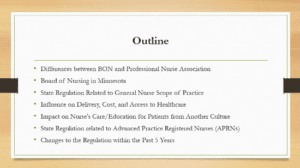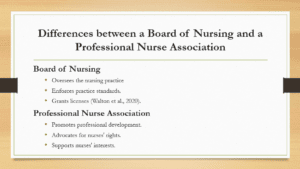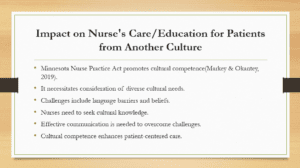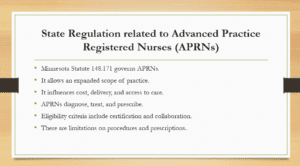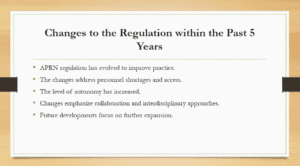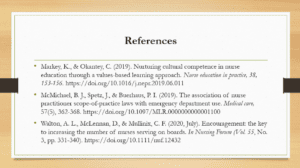Regulation For Nursing Practice Staff Development Meeting
Hello, and welcome to this presentation on Regulation for Nursing Practice Staff Development Meeting.
The presentation begins by highlighting the differences between the Board of Nursing (BON) and the Professional Nurse Association. It then focuses on the Board of Nursing in Minnesota, emphasizing its role in regulating nursing practice. Next, we will discuss the state regulation that defines the scope of practice for general nurses and its impact on healthcare delivery, cost, and access. We will further explore the influence of regulations on nurses’ care and education for patients from different cultures, emphasizing the importance of cultural competence. Lastly, the presentation covers the state regulation pertaining to Advanced Practice Registered Nurses (APRNs), including any recent changes made to the regulation.
A Board of Nursing is a regulatory body established by a state to oversee and implement nursing practice standards. Its main duty is to protect the public by ensuring that nurses meet the required qualifications, follow ethical guidelines, and maintain competency in their practice (Walton et al., 2020). The board grants nursing licenses, conducts disciplinary actions, and develops and administers licensing exams. Its role is primarily in the regulation and enforcement of nursing practice. On the other hand, a Professional Nurse Association is a voluntary organization composed of nurses. It aims to promote the interests and welfare of its members. It provides a platform for networking, professional development, and advocacy. Professional associations offer resources, educational opportunities, and support to nurses. They nurture professional growth and enhance the quality of nursing practice. They advocate for nurses’ rights, address policy issues, and promote progress in the field. While they may collaborate with regulatory bodies, their main role is representing and supporting the professional needs of nurses.
The Board of Nursing for Minnesota is the regulatory body responsible for the supervision of nursing practice in the state. The board consists of members appointed by the Governor. They include registered nurses, licensed practical nurses, and public members. The board is composed of nurses from different specialties and settings. This ensures a diverse representation. To become a member of the board, interested individuals go through a nomination and appointment process. The Governor’s office asks for applications from qualified individuals who meet the eligibility criteria. These criteria may include ownership of an active nursing license, having a certain number of years of nursing experience, and demonstration of commitment to public service. The selection process may involve reviewing applications, conducting interviews, and evaluating candidates’ qualifications and skills. Once selected, board members serve for a set duration. During this period, they fulfill their responsibilities. This consists of making policy decisions, implementing regulations, and protecting the public’s interest in nursing practice in Minnesota.
In Minnesota, a specific state regulation is the Minnesota Nurse Practice Act. This regulation outlines the legal boundaries within which nurses can practice and their responsibilities. According to the act, general nurses are allowed to provide direct patient care. This consists of assessment, planning, intervention, and evaluation of nursing care. They are allowed to administer medications, perform procedures, and work with other healthcare providers. However, there are limitations in their scope of practice. For instance, there are restrictions on prescribing medications and making medical diagnoses. The regulation has a significant influence on the nurse’s role. It sets clear guidelines for their practice and ensures patient safety. It establishes professional standards, ethical principles, and quality care expectations. The act also outlines the legal duties of nurses. The regulation directly impacts patient care and outcomes. It promotes safe and competent nursing practices. It helps ensure that patients receive appropriate and evidence-based care from qualified nurses. The act also establishes mechanisms for accountability and disciplinary actions. This maintains the integrity of the nursing profession. In the long run, adherence to this regulation contributes to improved patient outcomes and overall healthcare quality in Minnesota.
Defining the scope of practice and setting standards for nursing care helps provide expert patient care. Nurses are allowed to provide a wide range of services. This includes evaluations, treatments, and medication administration. The act also contributes to cost-effectiveness by allowing nurses to work at the top of their licensure. The need for unnecessary interventions or transfers to higher-cost providers is reduced. This leads to more efficient resource utilization and potentially lowers healthcare costs. The act expands the role of nurses and allows them to practice to the full extent of their education and training. Nurse practitioners can offer primary care services. This aids in bridging gaps in healthcare access and addressing the shortage of primary care physicians. It also leads to improved access to timely and affordable healthcare services for patients across Minnesota. Research has shown that states with broader nurse practice acts, similar to Minnesota’s, have better patient outcomes. Furthermore, they have lower healthcare costs and increased access to care. For instance, a study by McMichael et al., 2019 found that states with fewer restrictions on nurse practitioners had fewer emergency department visits and lower Medicare spending.
The act emphasizes the importance of cultural competence and sensitivity in nursing practice. Nurses need to respect and consider the different cultural needs of their patients. Incorporating cultural awareness builds trust, rapport, and effective communication (Markey & Okantey, 2019). There are challenges associated with cultural diversity. Language barriers, contradictory health beliefs, and cultural practices impact the delivery of care. Nurses can overcome these challenges by actively seeking cultural knowledge and creating effective communication strategies. For instance, they can use interpreters, use culturally appropriate assessment tools, and offer patient education materials in various languages. Furthermore, they can participate in cultural competency training. They can also collaborate with the patient’s family and community to better understand their needs. Nurses can promote a more inclusive healthcare environment in Minnesota by embracing cultural diversity.
Minnesota Statute 148.171 governs the practice of APRNs. This regulation outlines the responsibilities of APRNs, which go beyond the scope of a registered nurse. APRNs in Minnesota include nurse practitioners, clinical nurse specialists, nurse anesthetists, and nurse midwives. They can diagnose, treat, and prescribe medications within their area of expertise. To practice as APRNs, they must have national certification, collaboration with a licensed healthcare provider, and adherence to a written practice agreement. There are limitations on certain procedures and the prescription of controlled substances without collaboration. The regulation has shown positive impacts in terms of cost-effectiveness. There are reduced healthcare expenses and potentially lower costs for patients. APRNs play a vital role in addressing primary care shortages and improving access to cost-effective healthcare services. This, in turn, contributes to improved overall management of healthcare costs. The regulation significantly influences APRNs’ roles and positively impacts patient care. Ultimately, it leads to more efficient and effective healthcare delivery in Minnesota.
In the past 5 years, there have been significant changes to the regulations governing APRNs. These changes have aimed to modernize and expand the scope of practice for APRNs. It acknowledges their expertise and the evolving healthcare landscape. The reasons behind these changes include healthcare workforce shortages, improving access to care, and optimizing healthcare delivery. The changes have allowed APRNs to have more autonomy in diagnosing, treating, and prescribing medications. This is in line with their education and training. This has led to improved patient care outcomes, increased patient satisfaction, and reduced healthcare costs. The current state of the regulation reflects a more collaborative and integrated approach to healthcare. APRNs play an essential role as primary care providers and members of interdisciplinary teams. Looking ahead, potential future developments may focus on further expanding APRNs’ autonomy and ensuring regulatory consistency across states.
Markey, K., & Okantey, C. (2019). Nurturing cultural competence in nurse education through a values-based learning approach. Nurse education in practice, 38, 153-156. https://doi.org/10.1016/j.nepr.2019.06.011
McMichael, B. J., Spetz, J., & Buerhaus, P. I. (2019). The association of nurse practitioner scope-of-practice laws with emergency department use. Medical care, 57(5), 362-368. https://doi.org/10.1097/MLR.0000000000001100
Walton, A. L., McLennan, D., & Mullinix, C. F. (2020, July). Encouragement: the key to increasing the number of nurses serving on boards. In Nursing Forum (Vol. 55, No. 3, pp. 331-340). https://doi.org/10.1111/nuf.12432
ORDER A PLAGIARISM-FREE PAPER HERE
We’ll write everything from scratch
Question
Nursing is a very highly regulated profession. There are over 100 boards of nursing and national nursing associations throughout the United States and its territories. Their existence helps regulate, inform, and promote the nursing profession. With such numbers, it can be difficult to distinguish between BONs and nursing associations, and overwhelming to consider the various benefits and options offered by each.
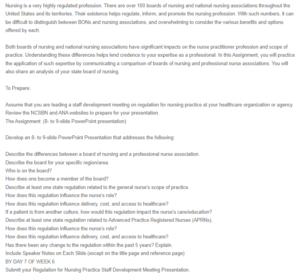
Regulation For Nursing Practice Staff Development Meeting
Both boards of nursing and national nursing associations have significant impacts on the nurse practitioner profession and scope of practice. Understanding these differences helps lend credence to your expertise as a professional. In this Assignment, you will practice the application of such expertise by communicating a comparison of boards of nursing and professional nurse associations. You will also share an analysis of your state board of nursing.
To Prepare:
Assume that you are leading a staff development meeting on regulation for nursing practice at your healthcare organization or agency.
Review the NCSBN and ANA websites to prepare for your presentation.
The Assignment: (8- to 9-slide PowerPoint presentation)
Develop an 8- to 9-slide PowerPoint Presentation that addresses the following:
Describe the differences between a board of nursing and a professional nurse association.
Describe the board for your specific region/area.
Who is on the board?
How does one become a member of the board?
Describe at least one state regulation related to the general nurse’s scope of practice.
How does this regulation influence the nurse’s role?
How does this regulation influence delivery, cost, and access to healthcare?
If a patient is from another culture, how would this regulation impact the nurse’s care/education?
Describe at least one state regulation related to Advanced Practice Registered Nurses (APRNs).
How does this regulation influence the nurse’s role?
How does this regulation influence delivery, cost, and access to healthcare?
Has there been any change to the regulation within the past 5 years? Explain.
Include Speaker Notes on Each Slide (except on the title page and reference page)
BY DAY 7 OF WEEK 6
Submit your Regulation for Nursing Practice Staff Development Meeting Presentation.


